Dosing & Uses
Dosage Forms & Strengths
capsule
- 400mg
tablet, chewable
- 100mg
- 200mg
oral suspension
- 100mg/5mL
- 200mg/5mL
- 500mg/5mL
Acute Exacerbations of Chronic Bronchitis
Indicated in the treatment of acute exacerbations of chronic bronchitis caused by susceptible isolates of Streptococcus pneumoniae and Haemophilus influenzae
400 mg/day PO in single daily dose or divided q12hr
Otitis Media
Indicated in the treatment of otitis media caused by susceptible isolates of Haemophilus influenzae, Moraxella catarrhalis, and Streptococcus pyogenes
400 mg/day PO in single daily dose or divided q12hr
Pharyngitis/Tonsillitis
Indicated in the treatment of pharyngitis and tonsillitis caused by susceptible isolates of Streptococcus pyogenes
400 mg/day PO in single daily dose or divided q12hr
Uncomplicated Gonorrhea
Alternative treatment of uncomplicated urogenital, anorectal, or pharyngeal gonorrhea if ceftriaxone unavailable; no longer indicated as first-line treatment, per CDC guidelines
400 mg PO once plus azithromycin 1 g PO once (preferred) or alternatively doxycycline 100 mg PO q12hr for 7 days
CDC STD guidelines: MMWR Recomm Rep. June 5, 2015:64(RR3);1-137
Uncomplicated Urinary Tract Infections
Indicated in the treatment of uncomplicated urinary tract infections caused by susceptible isolates of Escherichia coli and Proteus mirabilis
400 mg/day PO in single daily dose or divided q12hr
Typhoid Fever (Off-label)
15-20 mg/kg/day; not to exceed 100-200 mg BID x 7-14 days (WHO 2OO3)
Dosing Modifications
Renal impairment
- CrCl >60 mL/min: No dosage adjustment necessary
- CrCl 21-60 mL/min: 260 mg/day PO
- CrCl ≤20 mL/min or continuous peritoneal dialysis : 200 mg/day PO
Dosing Considerations
Treatment of infections due to Streptococcus pyogenes, cefixime should be administered for at least 10 days
Susceptible organisms
- Escherichia coli, Haemophilus influenzae, Neisseria gonorrhoeae, Proteus mirabilis, Streptococcus pneumoniae, Streptococcus pyogenes, Enterobacteriaceae, Salmonella spp, Serratia spp, Shigella spp
Dosage Forms & Strengths
capsule
- 400mg
tablet, chewable
- 100mg
- 200mg
oral suspension
- 100mg/5mL
- 200mg/5mL
- 500mg/5mL
Acute Bronchitis & Acute Exacerbations of Chronic Bronchitis
<6 months: Safety and efficacy not established
6 months-12 years, ≤45 kg: 8 mg/kg/day PO in single daily dose or divided q12hr
>12 years, >45 kg: 400 mg/day PO in single daily dose or divided q12hr
Otitis Media
<6 months: Safety and efficacy not established
6 months-12 years, ≤45 kg: 8 mg/kg/day PO in single daily dose or divided q12hr
>12 years, >45 kg: 400 mg/day PO in single daily dose or divided q12hr
Pharyngitis/Tonsillitis
<6 months: Safety and efficacy not established
6 months-12 years, ≤45 kg: 8 mg/kg/day PO in single daily dose or divided q12hr
>12 years, >45 kg: 400 mg/day PO in single daily dose or divided q12hr
Uncomplicated Gonorrhea
Cervical or urethral gonorrhea
<6 months: Safety and efficacy not established
6 months-12 years, ≤45 kg: 8 mg/kg/day PO in single daily dose or divided q12hr
>12 years, >45 kg: 400 mg PO once plus azithromycin 1 g in single dose or doxycycline 100 mg PO q12hr for 7 days
Uncomplicated Urinary Tract Infections
<6 months: Safety and efficacy not established
6 months-12 years, ≤45 kg: 8 mg/kg/day PO in single daily dose or divided q12hr
>12 years, >45 kg: 400 mg/day PO in single daily dose or divided q12hr
Typhoid Fever (Off-label)
15-20 mg/kg/day; not to exceed 100-200 mg BID x 7-14 days (WHO 2OO3)
Interactions
Interaction Checker
No Results

Contraindicated
Serious - Use Alternative
Significant - Monitor Closely
Minor

Contraindicated (0)
Serious - Use Alternative (4)
- BCG vaccine live
cefixime decreases effects of BCG vaccine live by pharmacodynamic antagonism. Contraindicated. Wait until Abx Tx complete to administer live bacterial vaccine.
- cholera vaccine
cefixime, cholera vaccine. pharmacodynamic antagonism. Avoid or Use Alternate Drug. Avoid coadministration of cholera vaccine with systemic antibiotics since these agents may be active against the vaccine strain. Do not administer cholera vaccine to patients who have received oral or parenteral antibiotics within 14 days prior to vaccination.
- microbiota oral
cefixime decreases effects of microbiota oral by pharmacodynamic antagonism. Avoid or Use Alternate Drug. Microbiota oral contains bacterial spores. Antibacterial agents may decrease efficacy if coadministered. Complete antibiotic regimens 2-4 days before initiating microbiota oral. .
- typhoid vaccine live
cefixime decreases effects of typhoid vaccine live by pharmacodynamic antagonism. Contraindicated. Wait until Abx Tx complete to administer live bacterial vaccine.
Monitor Closely (31)
- amikacin
cefixime increases toxicity of amikacin by nephrotoxicity and/or ototoxicity. Use Caution/Monitor. Cephalosporins may increase nephrotoxic effect of aminoglycosides. .
- atezolizumab
cefixime decreases effects of atezolizumab by unspecified interaction mechanism. Use Caution/Monitor. Coadministration may interfere with therapeutic effects of immune checkpoint inhibitors.
- avelumab
cefixime decreases effects of avelumab by unspecified interaction mechanism. Use Caution/Monitor. Coadministration may interfere with therapeutic effects of immune checkpoint inhibitors.
- balstilimab
cefixime decreases effects of balstilimab by unspecified interaction mechanism. Use Caution/Monitor. Coadministration may interfere with therapeutic effects of immune checkpoint inhibitors.
- bazedoxifene/conjugated estrogens
cefixime will decrease the level or effect of bazedoxifene/conjugated estrogens by altering intestinal flora. Applies only to oral forms of hormone. Low risk of contraceptive failure. Use Caution/Monitor.
- camrelizumab
cefixime decreases effects of camrelizumab by unspecified interaction mechanism. Use Caution/Monitor. Coadministration may interfere with therapeutic effects of immune checkpoint inhibitors.
- cemiplimab
cefixime decreases effects of cemiplimab by unspecified interaction mechanism. Use Caution/Monitor. Coadministration may interfere with therapeutic effects of immune checkpoint inhibitors.
- cosibelimab
cefixime decreases effects of cosibelimab by unspecified interaction mechanism. Use Caution/Monitor. Coadministration may interfere with therapeutic effects of immune checkpoint inhibitors.
- dienogest/estradiol valerate
cefixime will decrease the level or effect of dienogest/estradiol valerate by altering intestinal flora. Applies only to oral forms of hormone. Low risk of contraceptive failure. Use Caution/Monitor. An alternate or additional form of birth control may be advisable during concomitant use.
- dostarlimab
cefixime decreases effects of dostarlimab by unspecified interaction mechanism. Use Caution/Monitor. Coadministration may interfere with therapeutic effects of immune checkpoint inhibitors.
- durvalumab
cefixime decreases effects of durvalumab by unspecified interaction mechanism. Use Caution/Monitor. Coadministration may interfere with therapeutic effects of immune checkpoint inhibitors.
- estradiol
cefixime will decrease the level or effect of estradiol by altering intestinal flora. Applies only to oral forms of hormone. Low risk of contraceptive failure. Use Caution/Monitor.
- ethinylestradiol
cefixime will decrease the level or effect of ethinylestradiol by altering intestinal flora. Applies only to oral forms of hormone. Low risk of contraceptive failure. Use Caution/Monitor.
- gentamicin
cefixime increases toxicity of gentamicin by nephrotoxicity and/or ototoxicity. Use Caution/Monitor. Cephalosporins may increase nephrotoxic effect of aminoglycosides. .
- kanamycin
cefixime increases toxicity of kanamycin by nephrotoxicity and/or ototoxicity. Use Caution/Monitor. Cephalosporins may increase nephrotoxic effect of aminoglycosides. .
- levonorgestrel oral/ethinylestradiol/ferrous bisglycinate
cefixime will decrease the level or effect of levonorgestrel oral/ethinylestradiol/ferrous bisglycinate by altering intestinal flora. Applies only to oral forms of hormone. Low risk of contraceptive failure. Use Caution/Monitor. Antibiotics may decrease hormonal contraceptive efficacy.
- neomycin PO
cefixime increases toxicity of neomycin PO by nephrotoxicity and/or ototoxicity. Use Caution/Monitor. Cephalosporins may increase nephrotoxic effect of aminoglycosides. .
- nivolumab
cefixime decreases effects of nivolumab by unspecified interaction mechanism. Use Caution/Monitor. Coadministration may interfere with therapeutic effects of immune checkpoint inhibitors.
- pembrolizumab
cefixime decreases effects of pembrolizumab by unspecified interaction mechanism. Use Caution/Monitor. Coadministration may interfere with therapeutic effects of immune checkpoint inhibitors.
- penpulimab
cefixime decreases effects of penpulimab by unspecified interaction mechanism. Use Caution/Monitor. Coadministration may interfere with therapeutic effects of immune checkpoint inhibitors.
- plazomicin
cefixime increases toxicity of plazomicin by nephrotoxicity and/or ototoxicity. Use Caution/Monitor. Cephalosporins may increase nephrotoxic effect of aminoglycosides. .
- probenecid
probenecid will increase the level or effect of cefixime by acidic (anionic) drug competition for renal tubular clearance. Use Caution/Monitor.
- retifanlimab
cefixime decreases effects of retifanlimab by unspecified interaction mechanism. Use Caution/Monitor. Coadministration may interfere with therapeutic effects of immune checkpoint inhibitors.
- sintilimab
cefixime decreases effects of sintilimab by unspecified interaction mechanism. Use Caution/Monitor. Coadministration may interfere with therapeutic effects of immune checkpoint inhibitors.
- sodium picosulfate/magnesium oxide/anhydrous citric acid
cefixime decreases effects of sodium picosulfate/magnesium oxide/anhydrous citric acid by altering metabolism. Use Caution/Monitor. Coadministration with antibiotics decreases efficacy by altering colonic bacterial flora needed to convert sodium picosulfate to active drug.
- streptomycin
cefixime increases toxicity of streptomycin by nephrotoxicity and/or ototoxicity. Use Caution/Monitor. Cephalosporins may increase nephrotoxic effect of aminoglycosides. .
- tislelizumab
cefixime decreases effects of tislelizumab by unspecified interaction mechanism. Use Caution/Monitor. Coadministration may interfere with therapeutic effects of immune checkpoint inhibitors.
- tobramycin
cefixime increases toxicity of tobramycin by nephrotoxicity and/or ototoxicity. Use Caution/Monitor. Cephalosporins may increase nephrotoxic effect of aminoglycosides. .
- toripalimab
cefixime decreases effects of toripalimab by unspecified interaction mechanism. Use Caution/Monitor. Coadministration may interfere with therapeutic effects of immune checkpoint inhibitors.
- voclosporin
voclosporin, cefixime. Either increases toxicity of the other by nephrotoxicity and/or ototoxicity. Modify Therapy/Monitor Closely. Coadministration with drugs associated with nephrotoxicity may increase the risk for acute and/or chronic nephrotoxicity.
- warfarin
cefixime increases effects of warfarin by unspecified interaction mechanism. Use Caution/Monitor.
Minor (12)
- aminohippurate sodium
cefixime will increase the level or effect of aminohippurate sodium by acidic (anionic) drug competition for renal tubular clearance. Minor/Significance Unknown.
- aspirin
cefixime will increase the level or effect of aspirin by acidic (anionic) drug competition for renal tubular clearance. Minor/Significance Unknown.
- aspirin rectal
cefixime will increase the level or effect of aspirin rectal by acidic (anionic) drug competition for renal tubular clearance. Minor/Significance Unknown.
- aspirin/citric acid/sodium bicarbonate
cefixime will increase the level or effect of aspirin/citric acid/sodium bicarbonate by acidic (anionic) drug competition for renal tubular clearance. Minor/Significance Unknown.
- bendroflumethiazide
cefixime will increase the level or effect of bendroflumethiazide by acidic (anionic) drug competition for renal tubular clearance. Minor/Significance Unknown.
- chloramphenicol
chloramphenicol decreases effects of cefixime by pharmacodynamic antagonism. Minor/Significance Unknown.
- choline magnesium trisalicylate
cefixime will increase the level or effect of choline magnesium trisalicylate by acidic (anionic) drug competition for renal tubular clearance. Minor/Significance Unknown.
- cyclopenthiazide
cefixime will increase the level or effect of cyclopenthiazide by acidic (anionic) drug competition for renal tubular clearance. Minor/Significance Unknown.
- furosemide
cefixime increases toxicity of furosemide by pharmacodynamic synergism. Minor/Significance Unknown. Increased risk of nephrotoxicity.
- meloxicam
cefixime will increase the level or effect of meloxicam by acidic (anionic) drug competition for renal tubular clearance. Minor/Significance Unknown.
- rose hips
rose hips will increase the level or effect of cefixime by acidic (anionic) drug competition for renal tubular clearance. Minor/Significance Unknown.
- willow bark
cefixime will increase the level or effect of willow bark by acidic (anionic) drug competition for renal tubular clearance. Minor/Significance Unknown.
Adverse Effects
>10%
Diarrhea (16%)
Frequency Not Defined
Abdominal pain
Candidiasis
Dizziness
Dyspepsia
Elevated transaminases
Eosinophilia
Erythema multiforme
Fever
Flatulence
Headache
Increased blood urea nitrogen (BUN)
Increased creatinine
Leukopenia
Nausea
Prolonged prothrombin time (PT)
Pruritus
Pseudomembranous colitis
Rash
Serum sickness-like reaction
Stevens-Johnson syndrome
Thrombocytopenia
Urticaria
Vaginitis
Vomiting
Warnings
Contraindications
Documented hypersensitivity
Cautions
Limited activity against anaerobes
Dosage must be adjusted in severe renal insufficiency (high doses may cause CNS toxicity, including seizures); superinfections and promotion of nonsusceptible organisms may occur with prolonged use or repeated therapy
Use with caution in patients with history of penicillin allergy
Bacterial or fungal overgrowth of nonsusceptible organisms may occur with prolonged or repeated therapy
Immune-mediated hemolytic anemia reported; monitor hematologic parameters during and for 2 to 3 weeks after therapy; discontinue therapy if hemolytic anemia occurs during treatment
Phenylalanine can be harmful to patients with phenylketonuria (PKU); chewable tablets contain aspartame, a source of phenylalanine; before prescribing, consider combined daily amount of phenylalanine from all sources, including chewable tablets
Use caution in patients with history of gastrointestinal disease
Clostridium difficile associated diarrhea (CDAD) reported with use of nearly all antibacterial agents, and may range in severity from mild diarrhea to fatal colitis; if CDAD is suspected or confirmed, discontinue ongoing antibacterial drug use not directed against C. difficile; institute appropriate fluid and electrolyte management, protein supplementation, antibacterial drug treatment of C. difficile, and surgical evaluation as clinically indicated
Immune-mediated hemolytic anemia reported; monitor hematologic parameters during and for 2 to 3 weeks after therapy; discontinue therapy if hemolytic anemia occurs during treatment
Cephalosporins may be associated with a fall in prothrombin activity; patients with renal or hepatic impairment, or poor nutritional state, patients receiving a protracted course of antimicrobial therapy, and patients previously stabilized on anticoagulant therapy; monitor prothrombin time in patients at risk and exogenous vitamin K administered as indicated
May cause acute renal failure including tubulointerstitial nephritis; discontinue therapy if renal failure occurs and initiate supportive therapy
Severe cutaneous reactions, including Stevens-Johnson syndrome, epidermal necrolysis, and drug rash with eosinophilia and systemic symptoms (DRESS) reported; discontinue therapy and implement supportive therapy if reaction occurs
Drug interactions overview
- Concomitant use with cefixime and carbamazepine may elevate carbamazepine levels reported in postmarketing experience
- Administration of cefixime may result in a false-positive reaction for glucose in the urine using Clinitest®, Benedict’s solution, or Fehling’s solution; use glucose tests based on enzymatic glucose oxidase reactions (such as Clinistix® or TesTape®) be used
- A false-positive direct Coombs test reported during treatment with other cephalosporins; therefore, it should be recognized that a positive Coombs test may be due to the drug
Pregnancy & Lactation
Pregnancy
Available data from published observational studies, case series, and case reports over several decades with cephalosporin use, including cefixime, in pregnant women have not established drug-associated risks of major birth defects, miscarriage, or adverse maternal or fetal outcomes
Maternal gonorrhea may be associated with preterm birth, low neonatal birth weight, chorioamnionitis, intrauterine growth restriction, small for gestational age and premature rupture of membranes; perinatal transmission of gonorrhea to offspring can result in infant blindness, joint infections, and bloodstream infections
Animal data
- Reproduction studies have been performed in mice and rats at doses equivalent to 40 and 80 times, respectively, adult human recommended dose and have revealed no evidence of harm to the fetus due to cefixime
Lactation
There are no available data on presence of drug in human milk, effects on breastfed infant, or on milk production; drug is present in animal milk; when a drug is present in animal milk, it is likely the drug will be present in human milk; developmental and health benefits of breastfeeding should be considered along with mother’s clinical need for therapy and any potential adverse effects on breastfed infant from drug or from mother’s underlying condition
Pregnancy Categories
A: Generally acceptable. Controlled studies in pregnant women show no evidence of fetal risk.
B: May be acceptable. Either animal studies show no risk but human studies not available or animal studies showed minor risks and human studies done and showed no risk. C: Use with caution if benefits outweigh risks. Animal studies show risk and human studies not available or neither animal nor human studies done. D: Use in LIFE-THREATENING emergencies when no safer drug available. Positive evidence of human fetal risk. X: Do not use in pregnancy. Risks involved outweigh potential benefits. Safer alternatives exist. NA: Information not available.Pharmacology
Mechanism of Action
Third-generation oral cephalosporin with broad activity against gram-negative bacteria; by binding to 1 or more penicillin-binding proteins, it arrests bacterial cell-wall synthesis and inhibits bacterial growth
Absorption
Bioavailability: 40-50%
Average peak plasma concentration: ~2 mcg/mL (single 200 mg-tablet); ~3.7 mcg/mL (single 400 mg-tablet)
Peak plasma time: 2-6 hr (single 200mg, 400 mg–tablet or 400mg suspension); 2-5 hr (single 200 mg-suspension); 3-8 hr (single 400 mg-capsule)
Food reduces absorption following administration of the capsule by ~15% based on AUC and 25% based on peak plasma concentrations
Distribution
Distributed widely throughout body and reaches therapeutic concentration in most tissues and body fluids, including synovial, pericardial, pleural, and peritoneal; bile, sputum, and urine; bone, myocardium, gallbladder, skin, and soft tissue
Protein bound: 65%
Elimination
Half-life: 3-4 hr
Excretion: Urine (50% as unchanged drug), feces (10%)
Administration
Oral Suspension Preparation
Tap bottle several times to loosen powder contents prior to reconstitution
Add ~1/2 of the total amount of water for reconstitution and shake well (refer to prescribing information for specific volumes)
Add remainder of water and shake well
Oral Administration
Administer orally once or twice daily depending on indication
Do not substitute tablet or capsule for the chewable tablets or suspension in the treatment of otitis media
Chewable tablets must be chewed or crushed before swallowing
Storage
Capsules, chewable tablets, or tablets: Store at 20-25°C (68-77°F)
Unused suspension: Store at 20-25°C (68-77°F)
Reconstituted suspension
- Store at room temperature, or under refrigeration, without significant loss of potency for up to 14 days
- Keep tightly closed
- Shake well before using
- Discard unused portion after 14 days
Images
| BRAND | FORM. | UNIT PRICE | PILL IMAGE |
|---|---|---|---|
| cefixime oral - | 200 mg/5 mL suspension | 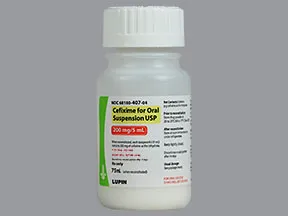 | |
| cefixime oral - | 100 mg/5 mL suspension | 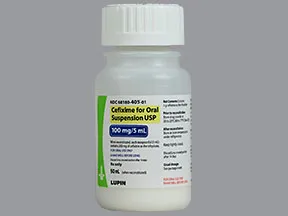 | |
| cefixime oral - | 200 mg/5 mL suspension | 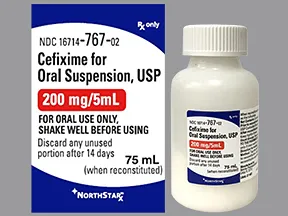 | |
| cefixime oral - | 200 mg/5 mL suspension |  | |
| cefixime oral - | 400 mg capsule | 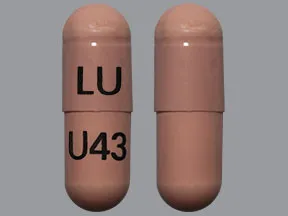 | |
| cefixime oral - | 200 mg/5 mL suspension | 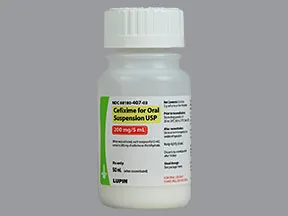 | |
| cefixime oral - | 200 mg/5 mL suspension | 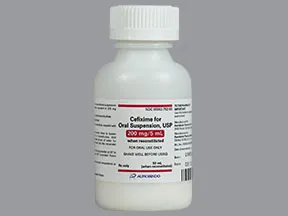 | |
| cefixime oral - | 200 mg/5 mL suspension | 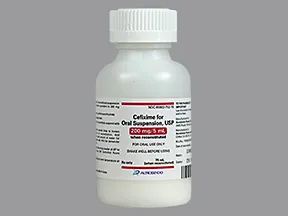 | |
| cefixime oral - | 100 mg/5 mL suspension | 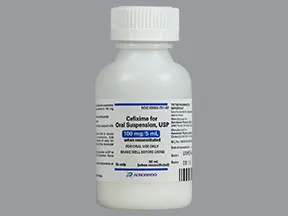 |
Copyright © 2010 First DataBank, Inc.
Patient Handout
cefixime oral
CEFIXIME - ORAL
(sef-IX-eem)
COMMON BRAND NAME(S): Suprax
USES: Cefixime is used to treat a wide variety of bacterial infections. This medication is known as a cephalosporin antibiotic. It works by stopping the growth of bacteria.This antibiotic treats only bacterial infections. It will not work for viral infections (such as common cold, flu). Using any antibiotic when it is not needed can cause it to not work for future infections.
HOW TO USE: Take this medication by mouth with or without food as directed by your doctor, usually once a day. In children, this medication may also be taken twice a day (every 12 hours). If you are taking the chewable tablets, chew thoroughly and then swallow.The dosage is based on your medical condition and response to treatment. In children, the dosage is also based on weight.For the best effect, take this antibiotic at evenly spaced times. To help you remember, take this medication at the same time(s) every day.Continue to use this medication until the full prescribed amount is finished, even if symptoms disappear after a few days. Stopping the medication too early may result in a return of the infection.Tell your doctor if your condition lasts or gets worse.
SIDE EFFECTS: Stomach upset/pain, diarrhea, nausea, gas, headache, or dizziness may occur. If any of these effects last or get worse, tell your doctor or pharmacist promptly.Remember that this medication has been prescribed because your doctor has judged that the benefit to you is greater than the risk of side effects. Many people using this medication do not have serious side effects.Tell your doctor right away if you have any serious side effects, including: nausea/vomiting that doesn't stop, severe stomach/abdominal pain, yellowing eyes/skin, dark urine, unusual tiredness, new signs of infection (such as sore throat that doesn't go away, fever), easy bruising/bleeding, signs of kidney problems (such as change in the amount of urine), mental/mood changes (such as confusion).This medication may rarely cause a severe intestinal condition due to a bacteria called C. difficile. This condition may occur during treatment or weeks to months after treatment has stopped. Tell your doctor right away if you develop: diarrhea that doesn't stop, abdominal or stomach pain/cramping, blood/mucus in your stool.If you have these symptoms, do not use anti-diarrhea or opioid products because they may make symptoms worse.Use of this medication for prolonged or repeated periods may result in oral thrush or a new vaginal yeast infection (oral or vaginal fungal infection). Contact your doctor if you notice white patches in your mouth, a change in vaginal discharge, or other new symptoms.A very serious allergic reaction to this drug is rare. However, get medical help right away if you notice any symptoms of a serious allergic reaction, including: rash, itching/swelling (especially of the face/tongue/throat), severe dizziness, trouble breathing.This is not a complete list of possible side effects. If you notice other effects not listed above, contact your doctor or pharmacist.In the US -Call your doctor for medical advice about side effects. You may report side effects to FDA at 1-800-FDA-1088 or at www.fda.gov/medwatch.In Canada - Call your doctor for medical advice about side effects. You may report side effects to Health Canada at 1-866-234-2345.
PRECAUTIONS: Before taking cefixime, tell your doctor or pharmacist if you are allergic to it; or to penicillins or other cephalosporin antibiotics (such as cephalexin); or if you have any other allergies. This product may contain inactive ingredients, which can cause allergic reactions or other problems. Talk to your pharmacist for more details.Before using this medication, tell your doctor or pharmacist your medical history, especially of: kidney disease, a certain intestinal disease (colitis).Cefixime may cause live bacterial vaccines (such as typhoid vaccine) to not work well. Tell your health care professional that you are using cefixime before having any immunizations/vaccinations.Before having surgery, tell your doctor or dentist about all the products you use (including prescription drugs, nonprescription drugs, and herbal products).The chewable form of this medication may contain aspartame. If you have phenylketonuria (PKU) or any other condition that requires you to limit/avoid aspartame (or phenylalanine) in your diet, ask your doctor or pharmacist about using this medication safely.During pregnancy, this medication should be used only when clearly needed. Discuss the risks and benefits with your doctor.It is unknown if this medication passes into breast milk. Consult your doctor before breastfeeding.
DRUG INTERACTIONS: Drug interactions may change how your medications work or increase your risk for serious side effects. This document does not contain all possible drug interactions. Keep a list of all the products you use (including prescription/nonprescription drugs and herbal products) and share it with your doctor and pharmacist. Do not start, stop, or change the dosage of any medicines without your doctor's approval.Products that may interact with this drug include: "blood thinners" (such as warfarin).This medication may interfere with certain lab tests (such as certain diabetic urine tests), possibly causing false test results. Make sure lab personnel and all your doctors know you use this drug.
OVERDOSE: If someone has overdosed and has serious symptoms such as passing out or trouble breathing, call 911. Otherwise, call a poison control center right away. US residents can call their local poison control center at 1-800-222-1222. Canada residents can call a provincial poison control center. Symptoms of overdose may include: severe vomiting, seizures.
NOTES: Do not share this medication with others.This medication has been prescribed for your current condition only. Do not use it later for another infection unless your doctor tells you to.
MISSED DOSE: If you miss a dose, take it as soon as you remember. If it is near the time of the next dose, skip the missed dose. Take your next dose at the regular time. Do not double the dose to catch up.
STORAGE: Store at room temperature away from light and moisture. Do not store in the bathroom. Keep all medications away from children and pets.Do not flush medications down the toilet or pour them into a drain unless instructed to do so. Properly discard this product when it is expired or no longer needed. Consult your pharmacist or local waste disposal company.
Information last revised March 2024. Copyright(c) 2024 First Databank, Inc.
IMPORTANT: HOW TO USE THIS INFORMATION: This is a summary and does NOT have all possible information about this product. This information does not assure that this product is safe, effective, or appropriate for you. This information is not individual medical advice and does not substitute for the advice of your health care professional. Always ask your health care professional for complete information about this product and your specific health needs.
Formulary
Adding plans allows you to compare formulary status to other drugs in the same class.
To view formulary information first create a list of plans. Your list will be saved and can be edited at any time.
Adding plans allows you to:
- View the formulary and any restrictions for each plan.
- Manage and view all your plans together – even plans in different states.
- Compare formulary status to other drugs in the same class.
- Access your plan list on any device – mobile or desktop.


